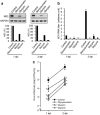Anti-hepatitis C virus compounds obtained from Glycyrrhiza uralensis and other Glycyrrhiza species
- PMID: 24397541
- PMCID: PMC7168410
- DOI: 10.1111/1348-0421.12127
Anti-hepatitis C virus compounds obtained from Glycyrrhiza uralensis and other Glycyrrhiza species
Abstract
Development of complementary and/or alternative drugs for treatment of hepatitis C virus (HCV) infection is still much needed from clinical and economic points of view. Antiviral substances obtained from medicinal plants are potentially good targets to study. Glycyrrhiza uralensis and G. glabra have been commonly used in both traditional and modern medicine. In this study, extracts of G. uralensis roots and their components were examined for anti-HCV activity using an HCV cell culture system. It was found that a methanol extract of G. uralensis roots and its chloroform fraction possess anti-HCV activity with 50%-inhibitory concentrations (IC(50)) of 20.0 and 8.0 μg/mL, respectively. Through bioactivity-guided purification and structural analysis, glycycoumarin, glycyrin, glycyrol and liquiritigenin were isolated and identified as anti-HCV compounds, their IC(50) being 8.8, 7.2, 4.6 and 16.4 μg/mL, respectively. However, glycyrrhizin, the major constituent of G. uralensis, and its monoammonium salt, showed only marginal anti-HCV activity. It was also found that licochalcone A and glabridin, known to be exclusive constituents of G. inflata and G. glabra, respectively, did have anti-HCV activity, their IC(50) being 2.5 and 6.2 μg/mL, respectively. Another chalcone, isoliquiritigenin, also showed anti-HCV activity, with an IC(50) of 3.7 μg/mL. Time-of-addition analysis revealed that all Glycyrrhiza-derived anti-HCV compounds tested in this study act at the post-entry step. In conclusion, the present results suggest that glycycoumarin, glycyrin, glycyrol and liquiritigenin isolated from G. uralensis, as well as isoliquiritigenin, licochalcone A and glabridin, would be good candidates for seed compounds to develop antivirals against HCV.
Keywords: antiviral substance; coumarin; hepatitis C virus.
© 2014 The Societies and Wiley Publishing Asia Pty Ltd.
Figures

Similar articles
-
Constituent properties of licorices derived from Glycyrrhiza uralensis, G. glabra, or G. inflata identified by genetic information.Biol Pharm Bull. 2007 Jul;30(7):1271-7. doi: 10.1248/bpb.30.1271. Biol Pharm Bull. 2007. PMID: 17603166
-
Glycyrrhizic acid as the antiviral component of Glycyrrhiza uralensis Fisch. against coxsackievirus A16 and enterovirus 71 of hand foot and mouth disease.J Ethnopharmacol. 2013 May 2;147(1):114-21. doi: 10.1016/j.jep.2013.02.017. Epub 2013 Feb 27. J Ethnopharmacol. 2013. PMID: 23454684 Free PMC article.
-
Antiviral activity of extracts from Morinda citrifolia leaves and chlorophyll catabolites, pheophorbide a and pyropheophorbide a, against hepatitis C virus.Microbiol Immunol. 2014 Mar;58(3):188-94. doi: 10.1111/1348-0421.12133. Microbiol Immunol. 2014. PMID: 24438164
-
A Review: The Pharmacology of Isoliquiritigenin.Phytother Res. 2015 Jul;29(7):969-77. doi: 10.1002/ptr.5348. Epub 2015 Apr 24. Phytother Res. 2015. PMID: 25907962 Review.
-
[Pharmaceutical botanical studies on some Glycyrrhiza species].Yakugaku Zasshi. 2003 Aug;123(8):619-31. doi: 10.1248/yakushi.123.619. Yakugaku Zasshi. 2003. PMID: 12931658 Review. Japanese.
Cited by
-
In Silico Study of Coumarins: Wedelolactone as a Potential Inhibitor of the Spike Protein of the SARS-CoV-2 Variants.J Trop Med. 2023 Feb 6;2023:4771745. doi: 10.1155/2023/4771745. eCollection 2023. J Trop Med. 2023. PMID: 39262685 Free PMC article.
-
Screening for anti-influenza virus compounds from traditional Mongolian medicine by GFP-based reporter virus.Front Cell Infect Microbiol. 2024 Jul 12;14:1431979. doi: 10.3389/fcimb.2024.1431979. eCollection 2024. Front Cell Infect Microbiol. 2024. PMID: 39071166 Free PMC article.
-
Glycyrol Prevents the Progression of Psoriasis-like Skin Inflammation via Immunosuppressive and Anti-Inflammatory Actions.Int J Mol Sci. 2023 Dec 11;24(24):17335. doi: 10.3390/ijms242417335. Int J Mol Sci. 2023. PMID: 38139164 Free PMC article.
-
Acacia mangium: A promising plant for isolating anti-hepatitis C virus agents.F1000Res. 2023 Aug 2;11:1452. doi: 10.12688/f1000research.124947.3. eCollection 2022. F1000Res. 2023. PMID: 38046541 Free PMC article.
-
Antiviral and antimicrobial applications of chalcones and their derivatives: From nature to greener synthesis.Heliyon. 2023 Sep 26;9(10):e20428. doi: 10.1016/j.heliyon.2023.e20428. eCollection 2023 Oct. Heliyon. 2023. PMID: 37810815 Free PMC article. Review.
References
-
- Gottwein J.M., Scheel T.K., Jensen T.B., Lademann J.B., Prentoe J.C., Knudsen M.L., Hoegh A.M., Bukh J. ( 2009) Development and characterization of hepatitis C virus genotype 1–7 cell culture systems: role of CD81 and scavenger receptor class B type I and effect of antiviral drugs. Hepatology 49: 364–77. - PubMed
-
- Moradpour D., Penin F., Rice C.M. ( 2007) Replication of hepatitis C virus. Nat Rev Microbiol 5: 453–6. - PubMed
-
- Arzumanyan A., Reis H.M., Feitelson M.A. ( 2013) Pathogenic mechanisms in HBV‐ and HCV‐associated hepatocellular carcinoma. Nat Rev Cancer 13: 123–35. - PubMed
Publication types
MeSH terms
Substances
LinkOut - more resources
Full Text Sources
Other Literature Sources
Medical

